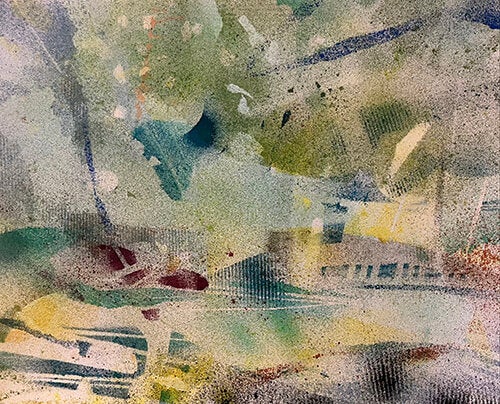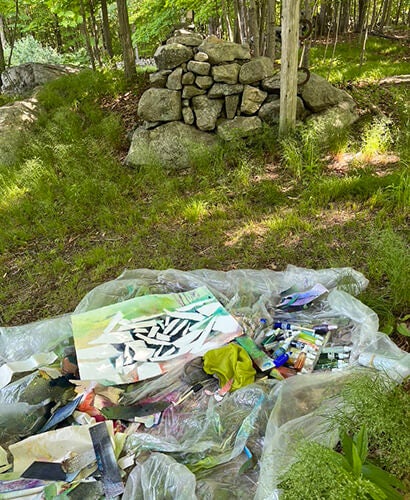Weir Farm is now a 68-acre national park, and the only national park for art. The Weir Farm Art Alliance selects 10 artists annually for its Artist-in-Residence (AIR) program. Reed is one of over 200 artists from around the world to have been selected for this residency program since its inception in the 1990s.
During her Artist-in-Residence experience, Reed lived in the Weir Farm caretaker’s cottage and worked in an adjacent large, light-filled contemporary studio, as well as creating art outdoors — or, “en plein air” — throughout the park. She produced numerous works that utilize composite stencils and atomized acrylic ink while synthesizing the practices of plein air and symbolic abstraction, focusing on both natural and man-made landscape configurations.
 “Overall, this artist residency provided uninterrupted time and a supportive environment for self-directed creative work,” Reed said. “I chose to apply to this particular Artist-in-Residence program because it was in a natural setting, offered housing and a large, private studio, and had been a subsistence farm at one time. The studio was really beautiful, situated above a waterway with a wall of windows and deck facing into the woods.
“Overall, this artist residency provided uninterrupted time and a supportive environment for self-directed creative work,” Reed said. “I chose to apply to this particular Artist-in-Residence program because it was in a natural setting, offered housing and a large, private studio, and had been a subsistence farm at one time. The studio was really beautiful, situated above a waterway with a wall of windows and deck facing into the woods.
“Discovering the extent to which artistic legacy is embedded in the mission and day-to-day operations of this national park was impressive. The geology of the region and the abundance of boulders, glacial erratics and rock walls are other reasons that I wanted to come here specifically. They relate to forms and ideas that are present in my current work, such as contemporary scholar rocks.”
 In terms of her own artwork, she said, “I am excited to have synthesized plein air painting with symbolic abstraction and to have found a process by which to respond to a specific site without describing it. I combined a great variety of positive and negative stencils to create composite forms and visual pathways. I expanded my palette of atomized acrylic ink dramatically and discovered methods to achieve more nuance and variety in its application. It was exhilarating to work in this nontraditional manner in such a history-laden place.”
In terms of her own artwork, she said, “I am excited to have synthesized plein air painting with symbolic abstraction and to have found a process by which to respond to a specific site without describing it. I combined a great variety of positive and negative stencils to create composite forms and visual pathways. I expanded my palette of atomized acrylic ink dramatically and discovered methods to achieve more nuance and variety in its application. It was exhilarating to work in this nontraditional manner in such a history-laden place.”
“The prodigious historical creative activity at Weir Farm was never far from my conscious ponderings and so I grounded myself in the immediacy of this place through senses and intellect. I participated in various programs including shinrin-yoku forest bathing, an Art and Agriculture tour, and a presentation regarding new research about one of the tenant farmers who had lived in the cottage that is the AIR residence, among others,” she said. “These and other activities deepened my sense of the environmental, social and economic realities that were part Weir Farm’s history and its geology. They also heightened my awareness of Weir Farm as a heavily mediated contemporary site.”
Reed made around 20 works on paper and canvas during her stay, ranging from small studies to full-sheet compositions. A selection of these will be exhibited in Moon Gallery at Berry College in Mount Berry, Georgia, for “Array,” her next solo art exhibition in October 2022.
Funding for Reed’s AIR project was provided by grants from the West Virginia Department of Arts, Culture, and History and the National Endowment for the Arts with approval from the West Virginia Commission on the Arts, the Marshall University College of Arts and Media, and the Drinko Academy at Marshall University. She plans to incorporate the experience into her teaching. “These experiences are relevant and inspiring examples for students! I look forward to aiding students in ART 390 Professional Practices this fall in researching and applying for opportunities that fit their individual aptitudes and interests,” she said.
When funding is available, the School of Art and Design sponsors students to participate in renowned residential workshops.
“I encourage patrons of the arts to designate a donation to the School of Art and Design for students to expand their knowledge through inspiring professional experiences in these and other programs,” Reed said.
To see an interview on Reed’s experience at Weir Farm, visit https://www.youtube.com/watch?v=y09hf6jNdog.
For more information about Marshall’s School of Art and Design, visit www.marshall.edu/art.
———–
Photos: (Top) Sandra Reed, a professor of art at Marshall, poses for a photo in front of the Artist-in-Residence studio at Weir Farm in Connecticut during the summer of 2022. (Middle) One of six plein air paintings created by Sandra Reed at Weir Farm in which negative and positive stencils were composited and atomized acrylic ink applied on paper.(Bottom) Marshall Art Professor Sandra Reed captured a photo of her plein air work site/set-up after using/making stencils and applying atomized paint during her Artist-in-Residence stay at Weir Farm in 2022.

